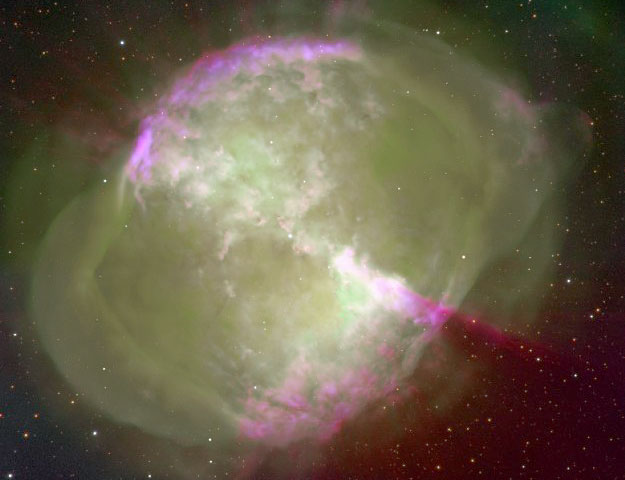If you haven't stopped by
Rob Gendler's astropics website before, you're in for a treat. He's good!
Below are 2 different images of M27 from
NOAO.

The Dumbbell Nebula in Hydrogen and Oxygen

M27: The Dumbbell Nebula
Dumbbell Nebula M27 in constellation Vulpecula
![[m27.jpg]](../JpgSm/m27.jpg)
| Right Ascension |
19 : 59.6 (h:m)
|
| Declination |
+22 : 43 (deg:m)
|
| Distance |
1.25 (kly)
|
| Visual Brightness |
7.4 (mag)
|
| Apparent Dimension |
8.0x5.7 (arc min)
|
Realize that these are long-exposure images. At the eyepiece of, say, an 8-inch 'scope, you will probably see something like this (but probably fainter):

To: MozartLover; Joan912; NovemberCharlie; snowfox; Dawgsquat; viligantcitizen; theDentist; ...
2 posted on
07/25/2003 5:26:44 AM PDT by
petuniasevan
(Contentsoftaglinemaysettlesomewhatduringtransmission.)
To: petuniasevan
Beautiful. I've seen it, but not like that.
To: petuniasevan
it is now popularly known as the Dumbbell Nebula, not for its substandard academic performance but for the elongated shape
Science humor - I love it!
4 posted on
07/25/2003 5:52:57 AM PDT by
GodBlessRonaldReagan
(where is Count Petofi when we need him most?)
To: petuniasevan
Marvellous!
To: petuniasevan
Great pictures!
Planetary nebulae frequently contain great arcs of matter that are denser than the surrounding nebula. This is an important clue about how the nebulae are formed. The standard explanation of planetary nebula formation suggests that these stars are at the end of life, and shed their outer layers in the process of becoming white dwarf stars.
If this were the case, one would expect the nebulae to be more uniform and spherical as the outer gas layers are blown out into space.
It is well known that most star systems have more than one star. When stars (or planets) pass too closely (within the Roche limit) to each other, the more massive body can pull matter from the surface of the less massive body. In the case of a main sequence star there is great internal pressure that helps to eject the surface material when the stellar companion passes close by. Some of the ejected matter may accrete onto the companion, and the remainder is blown outward by the solar wind, forming the dense arcs that we see.
This is illustrated in the picture below. Note the central star, and it's companion (northwest of the central star). There appears to be a faint trail of material (green) dragging behind the companion that leads toward the northeast. This appears as if the companion is in an elliptical orbit and moving counter clockwise around the central star as viewed in this image of the New Born Nebula.

Planetary nebulae may be more of an indicator of close orbits than stellar age.
FreeRepublic.com is powered by software copyright 2000-2008 John Robinson



![[m27.jpg]](../JpgSm/m27.jpg)

